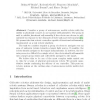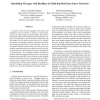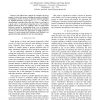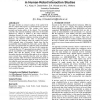HOLOMAS
2005
Springer
14 years 5 months ago
2005
Springer
Within this paper we describe a simulation environment for the underwater surveillance and propose architecture of control part of autonomous robot capable of efficient operation i...
ECAL
2005
Springer
14 years 5 months ago
2005
Springer
Consider a group of autonomous, mobile robots with the ability to physically connect to one another (self-assemble). The group is said to exhibit functional self-assembly if the ro...
ATAL
2005
Springer
14 years 5 months ago
2005
Springer
This paper introduces a multi-robot cooperation approach to solve the pursuit evasion problem for mobile robots that have omnidirectional vision sensors in unknown environments. T...
RTAS
2005
IEEE
14 years 5 months ago
2005
IEEE
Consider a team of robots equipped with sensors that collaborate with one another to achieve a common goal. Sensors on robots produce periodic updates that must be transmitted to ...
ICRA
2005
IEEE
14 years 5 months ago
2005
IEEE
Building cooperatively 3-D maps of unknown environments is one of the application fields of multi-robot systems. This article addressesthatproblemthroughaprobabilisticapproachbas...
ICRA
2005
IEEE
14 years 5 months ago
2005
IEEE
Abstract— We are developing a swarm-intelligent inspection system based on a swarm of autonomous, miniature robots, using only on-board, local sensors. To estimate intrinsic adva...
ICRA
2005
IEEE
14 years 5 months ago
2005
IEEE
— We address the synthesis of controllers for large groups of robots and sensors, tackling the specific problem of controlling a swarm of robots to generate patterns specified ...
AINA
2005
IEEE
14 years 5 months ago
2005
IEEE
In this paper, we consider a distributed system that consists of a group of teams of worker robots that rely on physical robot messengers for the communication between the teams. ...
HRI
2006
ACM
14 years 5 months ago
2006
ACM
This paper presents the combined results of two studies that investigated how a robot should best approach and place itself relative to a seated human subject. Two live Human Robo...
HRI
2006
ACM
14 years 5 months ago
2006
ACM
This paper describes an extensive analysis of the comfort level data of 7 subjects with respect to 12 robot behaviours as part of a human-robot interaction trial. This includes ro...




